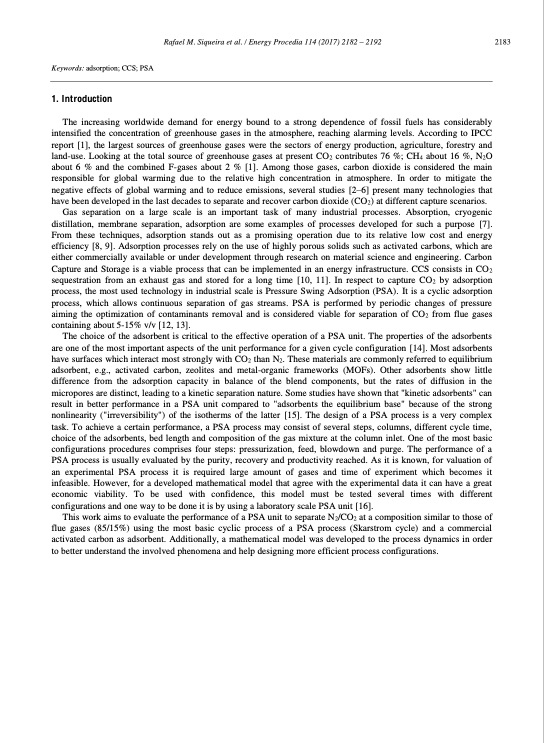
PDF Publication Title:
Text from PDF Page: 003
Keywords: adsorption; CCS; PSA Rafael M. Siqueira et al. / Energy Procedia 114 (2017) 2182 – 2192 2183 1. Introduction The increasing worldwide demand for energy bound to a strong dependence of fossil fuels has considerably intensified the concentration of greenhouse gases in the atmosphere, reaching alarming levels. According to IPCC report [1], the largest sources of greenhouse gases were the sectors of energy production, agriculture, forestry and land-use. Looking at the total source of greenhouse gases at present CO2 contributes 76 %; CH4 about 16 %, N2O about 6 % and the combined F-gases about 2 % [1]. Among those gases, carbon dioxide is considered the main responsible for global warming due to the relative high concentration in atmosphere. In order to mitigate the negative effects of global warming and to reduce emissions, several studies [2–6] present many technologies that have been developed in the last decades to separate and recover carbon dioxide (CO2) at different capture scenarios. Gas separation on a large scale is an important task of many industrial processes. Absorption, cryogenic distillation, membrane separation, adsorption are some examples of processes developed for such a purpose [7]. From these techniques, adsorption stands out as a promising operation due to its relative low cost and energy efficiency [8, 9]. Adsorption processes rely on the use of highly porous solids such as activated carbons, which are either commercially available or under development through research on material science and engineering. Carbon Capture and Storage is a viable process that can be implemented in an energy infrastructure. CCS consists in CO2 sequestration from an exhaust gas and stored for a long time [10, 11]. In respect to capture CO2 by adsorption process, the most used technology in industrial scale is Pressure Swing Adsorption (PSA). It is a cyclic adsorption process, which allows continuous separation of gas streams. PSA is performed by periodic changes of pressure aiming the optimization of contaminants removal and is considered viable for separation of CO2 from flue gases containing about 5-15% v/v [12, 13]. The choice of the adsorbent is critical to the effective operation of a PSA unit. The properties of the adsorbents are one of the most important aspects of the unit performance for a given cycle configuration [14]. Most adsorbents have surfaces which interact most strongly with CO2 than N2. These materials are commonly referred to equilibrium adsorbent, e.g., activated carbon, zeolites and metal-organic frameworks (MOFs). Other adsorbents show little difference from the adsorption capacity in balance of the blend components, but the rates of diffusion in the micropores are distinct, leading to a kinetic separation nature. Some studies have shown that "kinetic adsorbents" can result in better performance in a PSA unit compared to "adsorbents the equilibrium base" because of the strong nonlinearity ("irreversibility") of the isotherms of the latter [15]. The design of a PSA process is a very complex task. To achieve a certain performance, a PSA process may consist of several steps, columns, different cycle time, choice of the adsorbents, bed length and composition of the gas mixture at the column inlet. One of the most basic configurations procedures comprises four steps: pressurization, feed, blowdown and purge. The performance of a PSA process is usually evaluated by the purity, recovery and productivity reached. As it is known, for valuation of an experimental PSA process it is required large amount of gases and time of experiment which becomes it infeasible. However, for a developed mathematical model that agree with the experimental data it can have a great economic viability. To be used with confidence, this model must be tested several times with different configurations and one way to be done it is by using a laboratory scale PSA unit [16]. This work aims to evaluate the performance of a PSA unit to separate N2/CO2 at a composition similar to those of flue gases (85/15%) using the most basic cyclic process of a PSA process (Skarstrom cycle) and a commercial activated carbon as adsorbent. Additionally, a mathematical model was developed to the process dynamics in order to better understand the involved phenomena and help designing more efficient process configurations.PDF Image | Carbon Dioxide Capture by Pressure Swing Adsorption

PDF Search Title:
Carbon Dioxide Capture by Pressure Swing AdsorptionOriginal File Name Searched:
Carbondioxidecapturebypressureswingadsorption.pdfDIY PDF Search: Google It | Yahoo | Bing
CO2 Organic Rankine Cycle Experimenter Platform The supercritical CO2 phase change system is both a heat pump and organic rankine cycle which can be used for those purposes and as a supercritical extractor for advanced subcritical and supercritical extraction technology. Uses include producing nanoparticles, precious metal CO2 extraction, lithium battery recycling, and other applications... More Info
Heat Pumps CO2 ORC Heat Pump System Platform More Info
| CONTACT TEL: 608-238-6001 Email: greg@infinityturbine.com | RSS | AMP |